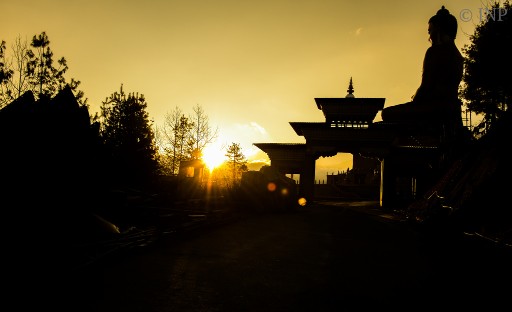Pilgrimages in Bhutan.
Paro Taktsang
Paro Taktsang's origins are shrouded in the mists of history just as its modern location is shrouded in mountain fog. Its remote location is centered around a taktsang (which means tiger's lair in Tibetan) - one of thirteen such Himalayan caves that were used for meditation by Guru Rinpoche, also known as Padma Sambhava. Legend tells us that he arrived in the Paro valley of Bhutan atop a flying tiger and meditated in the cave for exactly three years, three months, three weeks, three days and three hours before quelling some troublesome demons in the valley .Historians believe that the historical Padma Sambhava lived in the 8th century C.E. and that he was a member of a Brahmin,or upper caste, family in what is now Pakistan. He began practicing Tantric Buddhism as a young man and spent his life bringing Buddhism to the Himalayan region. Padma Sambhava is credited with introducing Buddhism to Bhutan, a remote mountain kingdom situated in the Himalayas between modern-day China and India, where Paro Taktsang is located. Farflung Paro Taktsang became a meditation spot for many important Tibetan Buddhist figures in the subsequent centuries, but it wasn't until the late 17th century that the temple was built. In 1692, Tenzin Rabgye visited the site and constructed a temple honoring Padma Sambhava. Tenzin Rabgye was a Bhutanese ruler believed to be the reincarnation of Padma Sambhava, and he timed his historic visit to mountain cave to coincide with the Tsechu dance festival.Legend tells us Tenzin Rabgye's Tsechu celebration was accompanied by dramatic miracles including flowers raining from the sky, the appearance of mythical beasts and Tenzin Rabgye simultaneously appearing inside and outside the cave.
Architecture
The temple complex at Paro Taktsang is made up of four temple buildings and a series of eight caves. The buildings are connected by a network of narrow stone walkways and a few rickety bridges, with the caves accessible behind the temple buildings.Like many prominent buildings in Bhutan, Paro Taktsang features stark white exterior walls and red shingled roofs as well as golden roofs. Temples in Bhutan are typically constructed of stone and rammed mud. In the courtyard, there is a large prayer wheel, which monks turn every morning to start the day. Tibetan Buddhists believe turning a prayer wheel is similar to reciting prayers orally.The interior of Paro Taktsang features golden ceilings, golden idols and the Hall of a Thousand Buddhas, where a statue of a large tiger can be found.
















